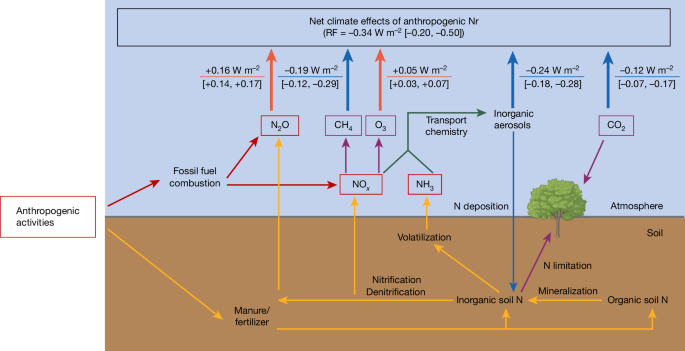Quantifying the Net Climate Impact of Anthropogenic Reactive Nitrogen Emissions Since the Industrial Revolution
핵심 개념
Anthropogenic reactive nitrogen has a net cooling effect on the global climate, but this effect may weaken in the future due to reduced aerosol loading and increased methane lifetime, while nitrous oxide-induced warming is likely to continue increasing.
초록
The content discusses the net climate effects of anthropogenic reactive nitrogen (Nr) since the pre-industrial era. Key points:
- Anthropogenic activities have substantially increased Nr loadings in the Earth system since pre-industrial times, contributing to eutrophication and air pollution.
- Increased Nr can influence global climate through various effects on atmospheric and land processes.
- The authors show that anthropogenic Nr causes a net negative direct radiative forcing of -0.34 W/m^2 in 2019 relative to 1850.
- This net cooling effect is due to increased aerosol loading, reduced methane lifetime, and increased terrestrial carbon sequestration, which outweigh the warming effects of enhanced atmospheric nitrous oxide and ozone.
- Future predictions using three representative scenarios suggest this cooling effect may be weakened, primarily due to reduced aerosol loading and increased methane lifetime, while N2O-induced warming is likely to continue increasing under all scenarios.
- The authors conclude that future reductions in anthropogenic Nr to achieve environmental protection goals need to be accompanied by enhanced efforts to reduce anthropogenic greenhouse gas emissions to mitigate climate change in line with the Paris Agreement.
요약 맞춤 설정
AI로 다시 쓰기
인용 생성
소스 번역
다른 언어로
마인드맵 생성
소스 콘텐츠 기반
소스 방문
www.nature.com
Global net climate effects of anthropogenic reactive nitrogen - Nature
통계
Anthropogenic Nr causes a net negative direct radiative forcing of -0.34 [−0.20, −0.50] W m−2 in 2019 relative to 1850.
인용구
"Anthropogenic activities have substantially enhanced the loadings of reactive nitrogen (Nr) in the Earth system since pre-industrial times1,2, contributing to widespread eutrophication and air pollution3,4,5,6."
"Here we show that anthropogenic Nr causes a net negative direct radiative forcing of −0.34 [−0.20, −0.50] W m−2 in the year 2019 relative to the year 1850."

더 깊은 질문
How might the regional distribution of anthropogenic Nr emissions and their climate effects vary across different parts of the world?
The regional distribution of anthropogenic Nr emissions can vary significantly across different parts of the world due to various factors such as population density, industrial activities, agricultural practices, and transportation. Regions with high agricultural intensity, such as parts of North America, Europe, and Asia, tend to have higher Nr emissions due to the use of nitrogen-based fertilizers and livestock production. On the other hand, regions with dense urban populations and industrial activities, like parts of China and India, may have elevated Nr emissions from combustion processes and industrial sources.
The climate effects of anthropogenic Nr emissions also vary regionally. For instance, regions with high Nr emissions from agricultural sources may experience increased eutrophication of water bodies and soil, leading to harmful algal blooms and loss of biodiversity. In contrast, regions with significant Nr emissions from industrial sources may face air pollution issues, including the formation of nitrogen oxides and particulate matter, which can have adverse health effects on local populations.
What other potential trade-offs or synergies exist between efforts to reduce Nr pollution and mitigate climate change?
Efforts to reduce Nr pollution and mitigate climate change can present both trade-offs and synergies. One potential trade-off is that certain strategies to reduce Nr pollution, such as decreasing nitrogen fertilizer use in agriculture, may inadvertently lead to lower crop yields, impacting food security. Similarly, some measures to mitigate climate change, like increasing biofuel production, can result in higher Nr emissions from agricultural activities, offsetting the intended climate benefits.
On the other hand, synergies can exist between Nr pollution reduction and climate change mitigation efforts. For example, promoting sustainable agricultural practices that optimize nitrogen use efficiency can not only reduce Nr pollution but also contribute to carbon sequestration in soils, aiding in climate change mitigation. Additionally, transitioning to renewable energy sources can help decrease Nr emissions from fossil fuel combustion, thereby addressing both air quality and climate change concerns simultaneously.
What innovative technological or policy approaches could simultaneously address both Nr pollution and greenhouse gas emissions in a more integrated manner?
One innovative approach to simultaneously address Nr pollution and greenhouse gas emissions is the implementation of precision agriculture technologies. These technologies utilize data-driven tools like remote sensing, GPS, and machine learning to optimize the application of nitrogen fertilizers, reducing Nr losses to the environment while maintaining crop productivity. By fine-tuning nitrogen inputs based on real-time data, precision agriculture can help mitigate Nr pollution and its associated environmental impacts.
Another promising strategy is the development of bioenergy with carbon capture and storage (BECCS) systems. BECCS involves producing bioenergy from biomass feedstocks, capturing the resulting carbon dioxide emissions, and storing them underground. By integrating BECCS with sustainable biomass production practices, such as perennial crops with nitrogen-fixing abilities, this approach can not only reduce greenhouse gas emissions but also mitigate Nr pollution by minimizing the need for synthetic nitrogen fertilizers.
Furthermore, policy frameworks that incentivize the adoption of integrated land management practices, such as agroforestry and wetland restoration, can promote both Nr pollution reduction and climate change mitigation. By encouraging multifunctional land use strategies that enhance ecosystem services, these policies can address the interconnected challenges of Nr pollution and greenhouse gas emissions in a holistic and sustainable manner.
0
